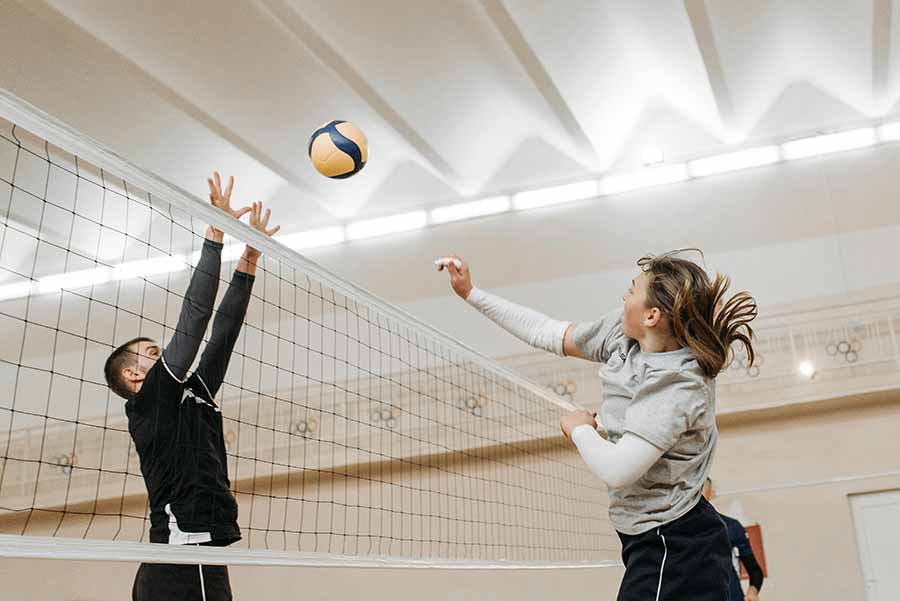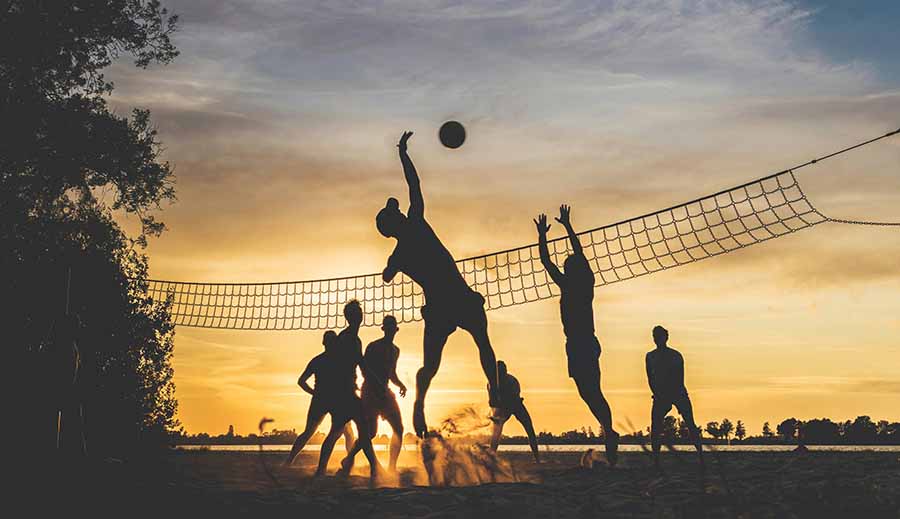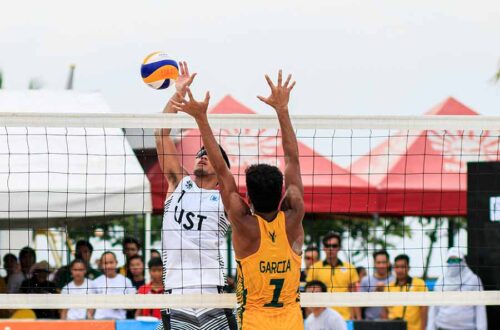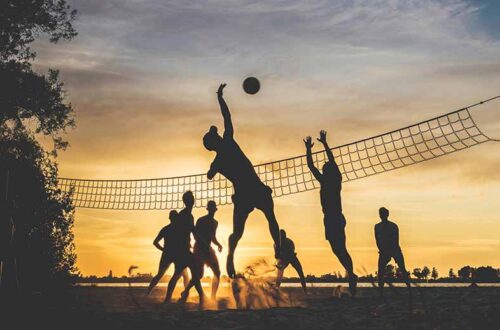Health
-
Beach Volleyball: Improving Your Speed on the Sand
Watching the professionals perform beach volleyball is really amazing. Their pose is flawless, ball positioning is on spot and their power to get back from a very long rally is uncanny. They make the game appear very easy, however if you’ve ever attempted playing beach volleyball, you’ll realize that it isn’t. On the top level of beach volleyball, physical fitness is generally an aspect which elevates the super-elite from the elite.
Professional beach players follow an intensive training routine in order to build up the power, strength, speed, aerobic workout and agility required to perform the game. Many spend a number of hours exercising 2 times each day. Even when you play indoor volleyball, various training programs are needed in order to develop the skills to play effectively on the beach. Having the right training, you as well could learn how to run, dig and jump on the sand of a beach volleyball court just like a professional.
The 2 qualities that skilled beach volleyball players should demonstrate are speed and footwork. If you wish to make improvements to your game, among the best approaches is to develop your skill to maneuver around the sand. A lot of indoor volleyball players would go outdoors to test their abilities in the beach and discover they’ve got some difficulty going around. Professionals call this as “getting your sand legs.” Though the skills which make you outstanding in indoor volleyball usually translate to beach volleyball, agility and speed could be slow to translate if you’re not used in moving around the sand.
Mainly because of the uneven nature of sand, sand training is helpful if you would like to enhance your intense strength and speed. We want to share a few tips for developing your ability to move around the beach volleyball court.
How to Better Your Play on Sand
When you initially move around the beach, you’ll unavoidably feel heavy and slow. Your agility would be affected, and also your vertical would drop. With a continuously shifting surface below your feet, it makes movements very hard. Thus how can you develop your skill to go around the actual beach volleyball court?

The first thing is to just move out and go on the sand. Have your morning jog around the beach. Do the training in the sand. Your body would be utilizing muscles which you do not utilize when playing in an indoor court. After a couple of weeks, your muscles will start to adjust and respond quicker while you’re on the sand.
Do the vertical jump while you are on the sand. Compared to the approach jump that you do in an indoor court, sand will give way beneath your feet. This requires valuable inches from your vertical and could make you feel slow.
On indoor volleyball, you could push off your feet in the hardwood in order to pass on the forward momentum straight into your jump. Having beach volleyball, this technique doesn’t do the job. Rather, concentrate more about your positioning and burst upwards. Prior to taking off, allow for a while to shift weight from forward to upward movement, this enables the sand below your feet to pack and give a little more vertical over the soft sand.
Whenever playing beach volleyball, a lot of indoor players feel like they’re simply coming short on digs or shifting to play on the ball. Whenever playing around the sand, you should concentrate in playing “through” the ball.
Don’t imagine the ball as the destination, and keep on moving your legs whenever you do a play on the ball. Indoor players tend to get to where the ball will nearly be, and be able to reach to do the play. In beach volleyball, you slow way quicker and would end up short on a lot of your plays when you don’t run through the ball.
-
What Do Coaches Look For During Volleyball Tryouts?
In any levels from middle school to college, coaches try to find specific characteristics in the volleyball player. Particularly for volleyball club tryouts, coaches monitor the players utilizing some sort of rating system in the different sought-after elements of ability.
Exactly what do volleyball coaches consider when searching for team tryouts? From our experience of coaching in the high school, club as well as collegiate level, there are actually 5 important categories in all levels: Athleticism, Communication, Coachability, Leadership and Skill.
Athleticism
This has aspects which could be trained and others that can’t. As an example, height can’t be influenced by training. Even though height has its own benefits in volleyball, it’s never good enough if the individual doesn’t have the other aspects, just like speed, power, and strength. In addition, it isn’t a replacement for other elements such as skill, leadership, and other. There have been occasions when the club team, who is the tallest player would likely experience insults coming from the other teams simply because the team was very small by comparison. Then again, it simply made it more fulfilling to overpower the team, particularly when college recruiters were viewing the game.
Communication
Coaches are interested in someone who is really vocal, dynamic and encouraging with teammates. They also look for the allied abilities of court vision as well as volleyball IQ, that involves critical thinking and problem solving skills. There is a significant difference in between talking — just like calling for the ball or yelling “I am open”– and communicating, that involves passing down information while you look at the game, just like the way the rival player serves, that can help the team.

While the best player is the fastest and highest jumping, the most effective volleyball player also exhibits a powerful volleyball IQ. Effective teams merge both kinds of athletes.
Coachability
In case you are an athlete trying out, you will have to show that you’re prepared to test something totally new — to modify strategy or adjust instead of being set on your own ways. Coaches search for a player who are able to correct his/her approach and accept criticism. A few athletes possess abilities and athletic skill, however they don’t like to change, particularly when they become older, thus coaching them “turns to an effort in futility.”
Leadership
In the tryout, coaches examine to know if you show leadership by your example, the way you work and associate with your team. Leadership likewise links into volleyball IQ: whether you understand what is happening in the court so you could assist direct traffic and manage what’s going on on a drill or scrimmage. “Do you have the ability to make people around you better by doing what you do?”, the usual question of the coaches. Seasoned coaches make this certainly one of their tryout standards.
Skill
Skill in volleyball is fully necessary. The team that possesses the very best abilities and would make the minimum errors will often win any given competition. They always screened all of the skills in the tryouts simply because they needed the players to actually perform a number of positions. You can never predict when the outside hitter, setter, middle blocker or libero will become ill or getting injured, thus you should have players who definitely are flexible and could all pass, set, strike, block, serve, as well as play defense. Despite the fact that volleyball is a specialized sport, teams who’ve got multi-skilled athletes tend to be the most successful. Additionally, it is vital that players have the ability to make alterations and available to instruction. A lot of coaches train methods in different ways and would anticipate their players to learn it their way.
-
Im not at the beach but I still want to play volleyball
Our top 3 places to keep playing volleyball when you are not at the beach.
Whats better than playing volleyball on a beautiful summers day with a group of friends at your local beach. Whether its 2 on 2 or a fun group game with your novice friends, beach volleyball is always a hit.
Unfortunately we can’t always be at the beach! Keep that volleyball spirit alive even when you are not ankle deep in the sand with the waves crashing in the back ground.
No 1: Pool Volleyball
Another great place to play volleyball and have fun with friends is in the pool. Pool Volleyball is a great way to include more in the volleyball fun, while still staying close to friends at home, while you are having a bbq or a family Sunday in the backyard.

Most of the time pool volleyball is just for fun but it can get pretty competitive. There can be some spectacular dives and saves in the pool and there is always a nice soft landing.
When playing pool volleyball make sure you have a quality pool volleyball set that is sturdy and has a taught net to keep things interesting. Then just grab your friends, jump in and play. Oh try get a set that has a waterproof volleyball as well. you don’t want to ruin your expensive volleyballs in the water.
No 2. In the garden or at a park
A fantastic place to play volleyball is in your local grassy park. You’ll often see nets set up in the park and a group of friends playing volleyball together. Grass volleyball is a great surface in between beach and indoor volleyball, its softer than the indoor courts but its easier to move un jump on the firmer grass when compared to soft beach sand.
But be careful you can still hurt yourself, and perhaps get a few grass burns while diving for the ball.
Portable volleyball nets that work for beach volleyball often work just as well for park volleyball.
No 3. Indoor volleyball
If you are looking to take things more seriously when you aren’t at the beach, why not join your local indoor volleyball club or team. You’ll make some great friends , improve your skills and fitness and have a blast.
There are a few difference between indoor and outdoor volleyball, so make sure you know the rule differences and get out there and have some fun.
Those are our best three alternatives to beach volleyball. We hope we inspired you to keep playing, training and having fun.
-
How to Improve Your Cardio for Beach Volleyball
Beach volleyball cardio workouts must be integrated into all serious player’s training regimen. Getting good endurance is required on the volleyball court if you wish to become a successful player. Beach volleyball definitely isn’t a sport in which you are running long distances, however the fact is that endurance and cardiovascular performance could be one of the best facets on your skill. Listed below are a few of the fitness tips for improving your cardiovascular performance in order to take your beach volleyball game to the next level!
1. Go Rowing
Most likely among the most ignored and underappreciated equipment in the gym, this challenging exercise is effective and it is a good form of cardio. As an excellent full-body high-intensity exercise, rowing functions over 85 % of the muscles on your body. This particular workout is low-impact and it is gentle in your joints because of the fluid movements done.
2. Perform Yoga
Yoga has numerous amazing health advantages, since it helps boost your flexibility, strength, sense of balance and it is great for your mental health. Also, it is a great way to boost your cardiovascular system, since the flowing in one position to another one raises your heart rate and performs the aerobic energy system.

By simply working the aerobic energy system you could make the body more effective in transforming oxygen right into energy.
3. Have a Walk
An easy, yet gentle method to enhance your cardiovascular system, heading out to get a walk is among the best workouts that can be done. To be able to make the most of walking’s cardiovascular advantages, walk rapidly and briskly, and work to include hilly terrain whenever possible to be able to increase difficulty and use-up more calories. Try to have a fast, brisk walk a minimum of 3 times each week for thirty minutes to one hour.
4. Do Burpees
Burpees are an excellent way to make sure that you obtain a full body workout which can help improve your strength, power, as well as cardio-respiratory endurance. Burpees work nearly all muscle in the body and whenever done at a high intensity can help boost cardiovascular endurance. For the reason that burpees work nearly every muscle, and so raises the body’s need for oxygen.
5. Jumping Rope
Man jump roping on sunny rural path
As a simple, but efficient way to boost your volleyball endurance, jumping rope can help condition the heart as well as the legs all at once because of the constant jumping which is associated with the exercise. Simply jump rope till you’re exhausted and then have thirty seconds of rest prior to doing it again. Include this easy, yet enjoyable exercise right into your schedule 2 to 3 times each week for about twenty minutes.
6. Meditate
It may seem weird that meditation is on the list, however meditation offers lots of advantages and could assist in improving your health. Meditation allows you to release stress, boosts your mood, aids lift up your self-esteem, enhances sleep, helps raise recovery time, reduces blood pressure level, and could aid strengthen your heart and enhance your cardiovascular health.
7. Perform Sprints
High-intensity interval training workouts which is accompanied by a short period of rest is an efficient method to work your heart as well as cardiovascular system. Sprints are most likely the simplest way to get a fast and efficient cardio session. Make sure to begin small and work your way up, raising the difficulty gradually and execute this 2 to 3 times each week.
8. Do Jogging
Doing a regular jogging regimen is a wonderful method to boost your cardiovascular endurance. Planning a schedule to jog a minimum of 3 days each week for 30-45 minutes is an excellent method to integrate this exercise right into your training routine. Your heart will be grateful for it since jogging could help enhance the power and performance of the heart.







